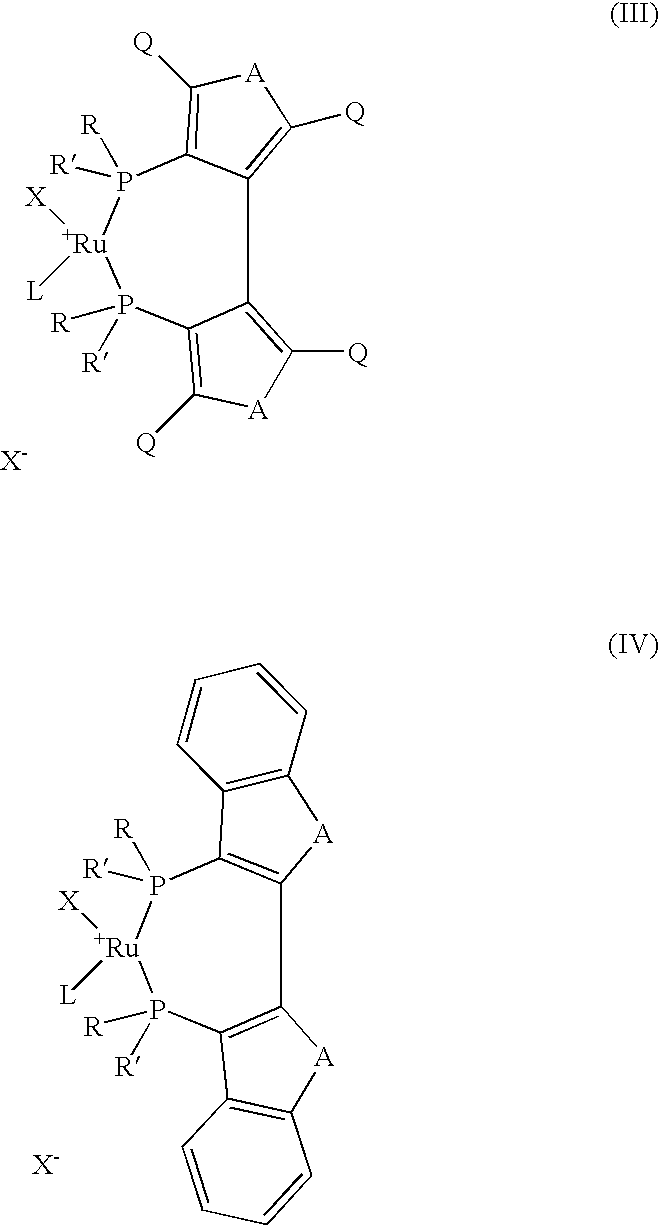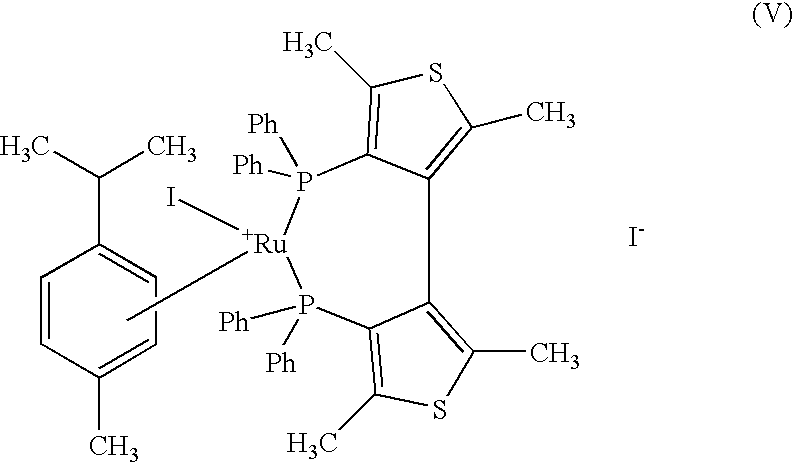Industrial process for the production of L-carnitine
a technology of l-carnitine and industrial process, which is applied in the direction of physical/chemical process catalysts, organic compounds/hydrides/coordination complex catalysts, organic chemistry, etc., can solve the problems of loss of 50% of the starting product, risk of imperfect reproducibility, and possible alterations of the strain used, so as to achieve easy industrial applicability
- Summary
- Abstract
- Description
- Claims
- Application Information
AI Technical Summary
Benefits of technology
Problems solved by technology
Method used
Image
Examples
example 2
Preparation of Ethyl (+) (R)-4-chloro-3-hydroxybutyrate
100 g of ethyl 4-chloro-3-oxobutyrate and 64.9 mg of {[Ru (p-cymene) I (+) TMBTP] I}, prepared in example 1, are placed under argon in a 3-liter reactor, in 1000 ml of ethyl alcohol degassed with argon; the mixture is heated at 120.degree. C. under argon and pressurised with hydrogen at 5 bar. After 3 h, the mixture is cooled, concentrated at reduced pressure, and the residue distilled with 5 mm Hg vacuum. 91 g of ethyl (+) (R)-4-chloro-3-hydroxybutyrate are obtained with an e.e. of 97% by gas-chromatography analysis.
example 3
Preparation of L-carnitine
8.4 g (0.05 mol) of ethyl (+) (R)-4-chloro-3-hydroxybutyrate and 23 ml (0.18 mol) of 45% trimethylamine in H.sub.2 O are placed in a 50 ml-vial. The vial is closed with a rubber plug, sealed with a ring cap and maintained at 80.degree. C. for 24 h. At the end of the reaction the vial is cooled and opened. The aqueous solution is transferred to a flask, 20 ml of methylene chloride are added and the resulting solution is left overnight under stirring. The aqueous phase is then recovered and eluted on a chromatography column containing 200 ml of Amberlite IRA 402 resin activated in the form of HCO.sub.3 --.
After elution of the first 30 ml, carnitine is eluted. The fractions containing L-carnitine (TLC analysis using CHCl.sub.3 42, isopropyl alcohol 7, methyl alcohol 28, H.sub.2 O 10.5, AcOH 10.5 as eluent), approximately 100-150 ml, are united and vacuum-concentrated. Isobutyl alcohol is used to form the azeotrope with water and completely eliminate the water....
examples 4-7
The hydrogenation procedure described in example 2 was repeated, changing the S:C ratios (Table 1), or operating with catalytic amounts of base (Table 2).
The results obtained are as follows:
The results in Table 1 show that, when operating with the catalysts described in the present invention, and under the reaction conditions indicated, it is possible to obtain ethyl 4-chloro-3-hydroxybutyrate in high yields and with high-grade enantiomeric optical purity.
PUM
| Property | Measurement | Unit |
|---|---|---|
| temperature | aaaaa | aaaaa |
| molar ratio | aaaaa | aaaaa |
| molar ratio | aaaaa | aaaaa |
Abstract
Description
Claims
Application Information
 Login to View More
Login to View More - R&D
- Intellectual Property
- Life Sciences
- Materials
- Tech Scout
- Unparalleled Data Quality
- Higher Quality Content
- 60% Fewer Hallucinations
Browse by: Latest US Patents, China's latest patents, Technical Efficacy Thesaurus, Application Domain, Technology Topic, Popular Technical Reports.
© 2025 PatSnap. All rights reserved.Legal|Privacy policy|Modern Slavery Act Transparency Statement|Sitemap|About US| Contact US: help@patsnap.com



